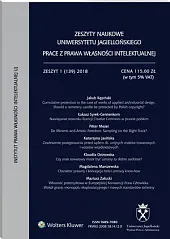Jakub Kępiński
p. 5
Łukasz Syrek-Gerstenkorn
p. 21
Péter Mezei
p. 56
Katarzyna Jasińska
p. 68
Klaudia Ostrowska
p. 88
Magdalena Marczewska
p. 111
Mariusz Załucki
p. 138
Jakub Kępiński
Cumulative protection in the case of works of applied art/industrial designs. Should a cemetery candle be protected by the Polish copyright law?
This commentary concerns a judgment issued by the Supreme Court on 6 March 2014 in case V CKS 202/15, in which copyright protection was granted to a cemetery candle with a very simple construction. Granting such protection has serious consequences, because currently, in the light of the judgment in point, one can hardly imagine any industrial design that could be refused protection under copyright law. The system of full cumulative protection is not ideal and gives rise to many practical problems. One of them is attempts to seek or extend protection under copyright law for goods with negligible manifestations of creativity or individual character. This author believes that an attempt should be made to defi ne in a more restrictive way the notion of ‘manifestation of creative activity of individual character’ with regard to any products of human intellectual activity.
Back to top
Łukasz Syrek-Gerstenkorn
Establishing a relationship of Creative Commons licence under Polish law
This article presents the basic information about the use of licences developed by Creative Commons organisation as alternatives to the traditional ‘ownership’ model of copyright law protection for various categories of works. The fi rst part is an attempt to systematise the most important information about Creative Commons licences; it gives an outline, in terms comprehensible also for those unfamiliar with the subject, of the increasingly popular phenomenon of free and open source software (FOSS) and the basic tenets of open source and open content movements, which underpin the Creative Commons system. To this end, in the introduction, the author analyses the origins of CC licences and the ideas on which they are founded, being a response to the phenomenon, which has for some time been observed in the area of intellectual property, of progressing expansion of conceptions based on ownership, which are the opposite of conceptions based on freedom. Then the author focuses on the structure of Creative Commons licences. Due to the particular method of construction of licence contents, the building blocks of individual variants of CC licences are presented. The author also presents the amendments introduced in the latest (fi fth) version of CC licences, marked as version 4.0; this is the fi rst one that has not been aligned with the legal order of any state. There is also an analysis of the notions of copyleft and share-alike, characteristic of Creative Commons licences, as well as the purpose of executing CC licence agreements and examples of their use in the legal transactions, especially on the Internet. The second part of this article discusses in detail how an individual Creative Commons licence agreement is entered into. The leading theme of this part is the intention to show how many problems, both theoretical and practical, arise if these licences are used in the Polish legal order. To this end, the procedure of establishing a relationship of Creative Commons licence is described step by step, both on the Internet and outside. There is also a presentation of the offer and acceptance as one of the possible ways of entering into the relationship of CC licence – and their nature of such licences as adhesion agreements. Furthermore, special attention should be drawn to reflections about the licence agreement as a relationship based on a unilateral legal transaction of granting authorisation to use a certain work, that is, the so-called licence authorisation in a pure form, as an alternative to the dominant view according to which it is a contract, as a legal transaction, that is the basis of a relationship of licence. The conducted analysis, which is just a contribution to in-depth refl ection on the establishment and legal character of Creative Commons licences, eventually leads to the thesis that despite the constantly growing popularity of CC licences and nearly fi fteen years after their fi rst version appeared on the Internet, the Polish legal system still lacks regulations directly concerning this way of distributing works within the meaning of copyright law. Due to the above, as well as due to the multi-plane and complex character of Creative Commons licence agreements, it seems reasonable to ask whether it is necessary to introduce in the Polish legal order comprehensive regulations on establishing and using licence relationships in the area of free and open source software.
Back to top
Péter Mezei
De Minimis and Artistic Freedom: Sampling on the Right Track?
The article focuses on the most recent American and European/German developments related to sampling of sound recordings. The latest case law on both sides of the Atlantic shows some departure from the earlier precedents, and allows for a more fl exible interpretation of samplers’ activities, which would free them from licensing preexisting protected subject matter. Nevertheless, the issue is still not fully settled in the European Union, as the German Federal Supreme Court has requested a preliminary ruling of the CJEU in the famous (or notorious) Metall auf Metall case. The article tries to predict the outcome of the preliminary ruling, which will most probably be published in 2018 or 2019.
Back to top
Katarzyna Jasińska
ZStaying the proceedings before an EU trade mark and Community design court
Provisions on staying the fact-fi nding civil proceedings are contained not only in the Code of Civil Procedure, but also in other legislative instruments, including instruments of EU law. These instruments include Regulation of the European Parliament and of the Council (EU) 2017/1001 of 14 June 2017 on the European Union trade mark and Council Regulation (EC) 6/2002 of 12 December 2001 on Community designs. These regulations - which are extremely important in practice, while notoriously diffi cult to interpret, and which cause discrepancies in case law – are discussed in this article.
The main topics the article touches upon include the question of staying proceedings pending before an EU trade mark and Community design court in case of the so-called related actions, that is, parallel proceedings pending before different EU trade mark and Community design courts or before such a court and the EUIPO, and in the case of the so-called counterclaim fi led in the course of proceedings before such a court, that is, in a situation when the right whose protection the claimant seeks to assert in court is challenged by the respondent by means of a counterclaim demanding that the right be pronounced extinct or invalidated. Among the above special attention should be drawn to a detailed interpretation, based on an analysis of case law, of the most controversial and problematic negative criterion for staying proceedings, that is, lack of special grounds for continuing the hearing. Refl ections on this matter are also referred to a situation – which is extremely hard to evaluate – when in the proceedings there is a cumulation f claimants and when there is a cumulation of grounds, that is, when the claim is based not only on EU provisions on exclusive rights, but also, for instance, on the provisions of the Act on Counteracting Unfair Competition (which should be seen as an equivalent of the passing off claim). The arguments presented in this article show how important all facts of a specifi c case are for interpretation of the provisions in question and how much the ratio legis of the analysed regulation matters in their interpretation.
Furthermore, the article concerns also staying proceedings in case of parallel civil actions one of which concerns protection of an EU trade mark (Community design), while the other an identical or similar trade mark (industrial design).
Finally, the article discusses an issue of great practical importance: that of the possibility of interlocutory injunctions to secure claims pursued before an EU trade mark and Community design court for the period when the proceedings are stayed.
Back to top
Klaudia Ostrowska
Can a trade mark be considered a personal interest?
In the course of trade it is a common practice that entrepreneurs do not register trade marks they use to mark their products or they register only a black-and-white version of the trade mark without applying for registration of its colour version, which they actually use, mainly because they wrongly assume that the registration of a black-and-white version of a trade mark is enough to cover all its colour versions. A problem arises when it turns out that another entrepreneur uses a sign which is identical with, or similar to, an unregistered trade mark or applies for registration of such a sign. Recognising the diffi culty of proceeding with an action based on the provisions of the Act of Combating Unfair Competition, the author analyses the case law and the literature in order to examine if a trade mark may be considered a personal interest which would facilitate the protection of trade marks and enable raising objections against the registration of a sign which is identical with, or similar to, an unregistered trade mark, based on the provisions of the Act – Industrial Property Law. This article is also intended as a polemic with the popular perception of the trade mark seen only as a property right.
Back to top
Magdalena Marczewska
Characteristics and contents of know-how agreements
The purpose of this article is to determine the legal nature of know-how agreements and present their contents. In this article the author tries to characterise know-how agreements in the Polish legal system. The article defi nes the concept of know-how, describes the particularities of know-how agreements, and their usefulness in business practice. It is based on the Polish industrial property law, supplemented with the views of representatives of the doctrine and confronted with the Polish jurisprudence.
Back to top
Mariusz Załucki
Industrial property in the European Convention on Human Rights. About the boundaries of monopoly of use and new protection standards
Industrial property is an area where the search for new standards of legal protection seems indispensable. It is the concept of a particular legislature that determines whether a given good is protected in this way and to what extent. At the present stage of development of law in this fi eld, the concept of transnational legal protection is interesting and tempting. The European Convention on Human Rights seems to be a possible basis for further exploring this option. The standards for the protection of property rights established by the Convention may appear to be useful for further development of industrial property rights.
Back to top






